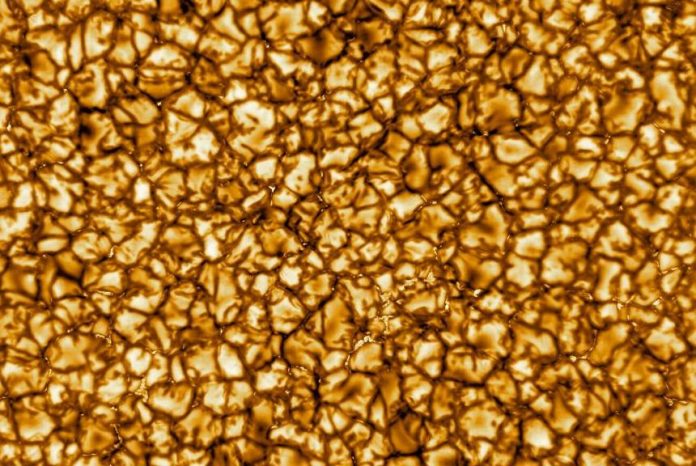Scientists have released the first images captured by the National Science Foundation’s Daniel K. Inouye Solar Telescope — the highest-resolution images of the sun’s surface yet to be captured.
The record photographs, captured by the 4-meter solar telescope from the summit of Haleakala, Maui, in Hawaii, reveal a “boiling” pattern of intense turbulence within the plasma layer that encircles the sun. The surface of the roiling plasma appears broken into cell-like panels.
Each of the panels contain cycles of convection, with the hottest plasma rising to the center and then moving to the edges before sinking as it cools.
Scientists with the National Science Foundation expect the Daniel K. Inouye Solar Telescope — which features a 13-foot mirror, a record for solar telescopes — to usher in a new era of solar science and provide fresh insights into the electromagnetic dynamics that fuel the sun’s most energetic phenomena.
RELATED Scientists pinpoint release of energy that powered series of solar flares
“Since NSF began work on this ground-based telescope, we have eagerly awaited the first images,” France Córdova, director of the National Science Foundation, said in a news release. “We can now share these images and videos, which are the most detailed of our sun to date.”
“NSF’s Inouye Solar Telescope will be able to map the magnetic fields within the sun’s corona, where solar eruptions occur that can impact life on Earth,” Córdova said. “This telescope will improve our understanding of what drives space weather and ultimately help forecasters better predict solar storms.”
Observations made by the Inouye Solar Telescope will help scientists study the behavior of the highly variable magnetic fields that flow through the sun’s plasma. By modeling the electromagnetic process playing out on the sun’s surface, researchers hope to improve their ability to predict space weather. More accurate space weather predictions can help engineers better protect satellite communication systems and power grids from interference.
RELATED Data from Parker Solar Probe helps unravel sun’s mysteries
While the accuracy of terrestrial weather forecasting continues to improve, scientists have struggled to improve the best space weather models.
“Our predictions lag behind terrestrial weather by 50 years, if not more,” said Matt Mountain, president of the Association of Universities for Research in Astronomy, which manages the new Hawaiian telescope. “What we need is to grasp the underlying physics behind space weather, and this starts at the sun, which is what the Inouye Solar Telescope will study over the next decades.”
The new telescope can capture the intricacies of the sun’s tiny panels of electromagnetic energy in greater detail than ever before. These intricacies could hold the secrets to the processes that power phenomena like sunspots and solar flares.
RELATED New observations help explain why sun’s upper atmosphere is hotter than its surface
“It’s all about the magnetic field,” said Thomas Rimmele, director of the Inouye Solar Telescope. “To unravel the sun’s biggest mysteries, we have to not only be able to clearly see these tiny structures from 93 million miles away but very precisely measure their magnetic field strength and direction near the surface and trace the field as it extends out into the million-degree corona, the outer atmosphere of the sun.”
The construction of the Inouye Solar Telescope was no easy feat. The massive mirror produces a lot of heat. Engineers had to construct seven miles of piping to pump coolant throughout the expansive observatory.
“The focus of the telescope mirror is hot enough to melt metal within a short time,” Rimmele said. “To deal with these heat problems we make the equivalent of a swimming pool full of ice every night to provide cooling for the optics and structure during the day.”
UPI

Putting a spotlight on business, inventions, leadership, influencers, women, technology, and lifestyle. We inspire, educate, celebrate success and reward resilience.















